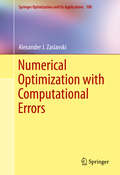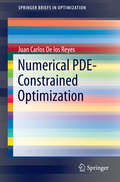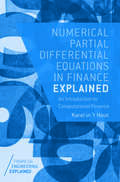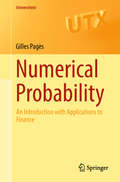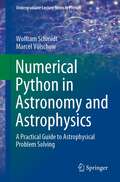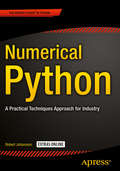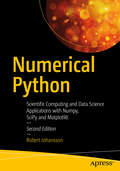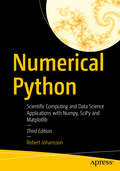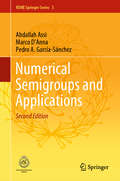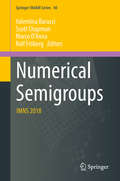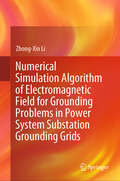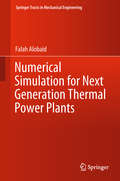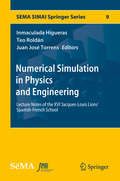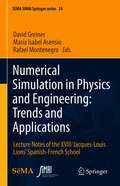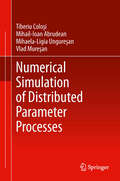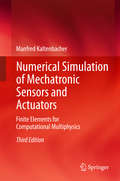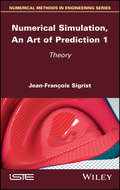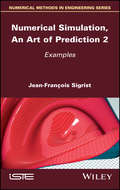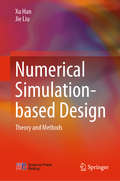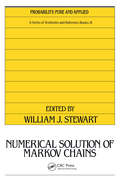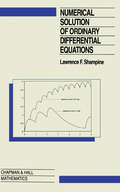- Table View
- List View
Numerical Optimization with Computational Errors
by Alexander J. ZaslavskiThis book studies the approximate solutions of optimization problems in the presence of computational errors. A number of results are presented on the convergence behavior of algorithms in a Hilbert space; these algorithms are examined taking into account computational errors. The author illustrates that algorithms generate a good approximate solution, if computational errors are bounded from above by a small positive constant. Known computational errors are examined with the aim of determining an approximate solution. Researchers and students interested in the optimization theory and its applications will find this book instructive and informative. This monograph contains 16 chapters; including a chapters devoted to the subgradient projection algorithm, the mirror descent algorithm, gradient projection algorithm, the Weiszfelds method, constrained convex minimization problems, the convergence of a proximal point method in a Hilbert space, the continuous subgradient method, penalty methods and Newton s method. "
Numerical PDE-Constrained Optimization
by Juan Carlos De los ReyesThis book introduces, in an accessible way, the basic elements of Numerical PDE-Constrained Optimization, from the derivation of optimality conditions to the design of solution algorithms. Numerical optimization methods in function-spaces and their application to PDE-constrained problems are carefully presented. The developed results are illustrated with several examples, including linear and nonlinear ones. In addition, MATLAB codes, for representative problems, are included. Furthermore, recent results in the emerging field of nonsmooth numerical PDE constrained optimization are also covered. The book provides an overview on the derivation of optimality conditions and on some solution algorithms for problems involving bound constraints, state-constraints, sparse cost functionals and variational inequality constraints.
Numerical Partial Differential Equations in Finance Explained
by Karel in 't HoutThis book provides a first, basic introduction into the valuation of financial options via the numerical solution of partial differential equations (PDEs). It provides readers with an easily accessible text explaining main concepts, models, methods and results that arise in this approach. In keeping with the series style, emphasis is placed on intuition as opposed to full rigor, and a relatively basic understanding of mathematics is sufficient. The book provides a wealth of examples, and ample numerical experiments are givento illustrate the theory. The main focus is on one-dimensional financial PDEs, notably the Black-Scholes equation. The book concludes with a detailed discussion of the important step towards two-dimensional PDEs in finance.
Numerical Probability: An Introduction with Applications to Finance (Universitext)
by Gilles PagèsThis textbook provides a self-contained introduction to numerical methods in probability with a focus on applications to finance. Topics covered include the Monte Carlo simulation (including simulation of random variables, variance reduction, quasi-Monte Carlo simulation, and more recent developments such as the multilevel paradigm), stochastic optimization and approximation, discretization schemes of stochastic differential equations, as well as optimal quantization methods. The author further presents detailed applications to numerical aspects of pricing and hedging of financial derivatives, risk measures (such as value-at-risk and conditional value-at-risk), implicitation of parameters, and calibration. Aimed at graduate students and advanced undergraduate students, this book contains useful examples and over 150 exercises, making it suitable for self-study.
Numerical Python in Astronomy and Astrophysics: A Practical Guide to Astrophysical Problem Solving (Undergraduate Lecture Notes in Physics)
by Wolfram Schmidt Marcel VölschowThis book provides a solid foundation in the Python programming language, numerical methods, and data analysis, all embedded within the context of astronomy and astrophysics. It not only enables students to learn programming with the aid of examples from these fields but also provides ample motivation for engagement in independent research. The book opens by outlining the importance of computational methods and programming algorithms in contemporary astronomical and astrophysical research, showing why programming in Python is a good choice for beginners. The performance of basic calculations with Python is then explained with reference to, for example, Kepler’s laws of planetary motion and gravitational and tidal forces. Here, essential background knowledge is provided as necessary. Subsequent chapters are designed to teach the reader to define and use important functions in Python and to utilize numerical methods to solve differential equations and landmark dynamical problems in astrophysics. Finally, the analysis of astronomical data is discussed, with various hands-on examples as well as guidance on astronomical image analysis and applications of artificial neural networks.
Numerical Python: A Practical Techniques Approach for Industry
by Robert JohanssonNumerical Python by Robert Johansson shows you how to leverage the numerical and mathematical modules in Python and its Standard Library as well as popular open source numerical Python packages like NumPy, FiPy, matplotlib and more to numerically compute solutions and mathematically model applications in a number of areas like big data, cloud computing, financial engineering, business management and more. After reading and using this book, you'll get some takeaway case study examples of applications that can be found in areas like business management, big data/cloud computing, financial engineering (i. e. , options trading investment alternatives), and even games. Up until very recently, Python was mostly regarded as just a web scripting language. Well, computational scientists and engineers have recently discovered the flexibility and power of Python to do more. Big data analytics and cloud computing programmers are seeing Python's immense use. Financial engineers are also now employing Python in their work. Python seems to be evolving as a language that can even rival C++, Fortran, and Pascal/Delphi for numerical and mathematical computations.
Numerical Python: Scientific Computing and Data Science Applications with Numpy, SciPy and Matplotlib
by Robert Johansson<p>Leverage the numerical and mathematical modules in Python and its standard library as well as popular open source numerical Python packages like NumPy, SciPy, FiPy, matplotlib and more. This fully revised edition, updated with the latest details of each package and changes to Jupyter projects, demonstrates how to numerically compute solutions and mathematically model applications in big data, cloud computing, financial engineering, business management and more. <p>Numerical Python, Second Edition, presents many brand-new case study examples of applications in data science and statistics using Python, along with extensions to many previous examples. Each of these demonstrates the power of Python for rapid development and exploratory computing due to its simple and high-level syntax and multiple options for data analysis. <p>After reading this book, readers will be familiar with many computing techniques including array-based and symbolic computing, visualization and numerical file I/O, equation solving, optimization, interpolation and integration, and domain-specific computational problems, such as differential equation solving, data analysis, statistical modeling and machine learning. <p>What You'll Learn <p> <li>Work with vectors and matrices using NumPy <li>Plot and visualize data with Matplotlib <li>Perform data analysis tasks with Pandas and SciPy <li>Review statistical modeling and machine learning with statsmodels and scikit-learn <li>Optimize Python code using Numba and Cython</li> <p> <p>Who This Book Is For: <p> <li>Developers who want to understand how to use Python and its related ecosystem for numerical computing. </li></p>
Numerical Python: Scientific Computing and Data Science Applications with Numpy, SciPy and Matplotlib
by Robert JohanssonLearn how to leverage the scientific computing and data analysis capabilities of Python, its standard library, and popular open-source numerical Python packages like NumPy, SymPy, SciPy, matplotlib, and more. This book demonstrates how to work with mathematical modeling and solve problems with numerical, symbolic, and visualization techniques. It explores applications in science, engineering, data analytics, and more. Numerical Python, Third Edition, presents many case study examples of applications in fundamental scientific computing disciplines, as well as in data science and statistics. This fully revised edition, updated for each library's latest version, demonstrates Python's power for rapid development and exploratory computing due to its simple and high-level syntax and many powerful libraries and tools for computation and data analysis. After reading this book, readers will be familiar with many computing techniques, including array-based and symbolic computing, visualization and numerical file I/O, equation solving, optimization, interpolation and integration, and domain-specific computational problems, such as differential equation solving, data analysis, statistical modeling, and machine learning. What You'll Learn Work with vectors and matrices using NumPy Review Symbolic computing with SymPy Plot and visualize data with Matplotlib Perform data analysis tasks with Pandas and SciPy Understand statistical modeling and machine learning with statsmodels and scikit-learn Optimize Python code using Numba and Cython Who This Book Is For Developers who want to understand how to use Python and its ecosystem of libraries for scientific computing and data analysis.
Numerical Ranges of Hilbert Space Operators (Encyclopedia of Mathematics and its Applications #179)
by Hwa-Long Gau Pei Yuan WuNumerical Relativity: Solving Einstein's Equations on the Computer
by Thomas W. Baumgarte Stuart L. ShapiroAimed at students and researchers entering the field, this pedagogical introduction to numerical relativity will also interest scientists seeking a broad survey of its challenges and achievements. Assuming only a basic knowledge of classical general relativity, the book develops the mathematical formalism from first principles, and then highlights some of the pioneering simulations involving black holes and neutron stars, gravitational collapse and gravitational waves. The book contains 300 exercises to help readers master new material as it is presented. Numerous illustrations, many in color, assist in visualizing new geometric concepts and highlighting the results of computer simulations. Summary boxes encapsulate some of the most important results for quick reference. Applications covered include calculations of coalescing binary black holes and binary neutron stars, rotating stars, colliding star clusters, gravitational and magnetorotational collapse, critical phenomena, the generation of gravitational waves, and other topics of current physical and astrophysical significance.
Numerical Semigroups and Applications (RSME Springer Series #3)
by Abdallah Assi Pedro A. García-Sánchez Marco D'AnnaThis book is an extended and revised version of "Numerical Semigroups with Applications," published by Springer as part of the RSME series. Like the first edition, it presents applications of numerical semigroups in Algebraic Geometry, Number Theory and Coding Theory. It starts by discussing the basic notions related to numerical semigroups and those needed to understand semigroups associated with irreducible meromorphic series. It then derives a series of applications in curves and factorization invariants. A new chapter is included, which offers a detailed review of ideals for numerical semigroups. Based on this new chapter, descriptions of the module of Kähler differentials for an algebroid curve and for a polynomial curve are provided. Moreover, the concept of tame degree has been included, and is viewed in relation to other factorization invariants appearing in the first edition. This content highlights new applications of numerical semigroups and their ideals, following in the spirit of the first edition.
Numerical Semigroups: IMNS 2018 (Springer INdAM Series #40)
by Scott Chapman Valentina Barucci Marco D’Anna Ralf FröbergThis book presents the state of the art on numerical semigroups and related subjects, offering different perspectives on research in the field and including results and examples that are very difficult to find in a structured exposition elsewhere. The contents comprise the proceedings of the 2018 INdAM “International Meeting on Numerical Semigroups”, held in Cortona, Italy. Talks at the meeting centered not only on traditional types of numerical semigroups, such as Arf or symmetric, and their usual properties, but also on related types of semigroups, such as affine, Puiseux, Weierstrass, and primary, and their applications in other branches of algebra, including semigroup rings, coding theory, star operations, and Hilbert functions. The papers in the book reflect the variety of the talks and derive from research areas including Semigroup Theory, Factorization Theory, Algebraic Geometry, Combinatorics, Commutative Algebra, Coding Theory, and Number Theory. The book is intended for researchers and students who want to learn about recent developments in the theory of numerical semigroups and its connections with other research fields.
Numerical Simulation Algorithm of Electromagnetic Field for Grounding Problems in Power System Substation Grounding Grids
by Zhong-Xin LiThis book focuses on numerical methods for grounding problems in substation grounding systems, which are rooted in horizontal multilayered earth models. The book discusses both theories and engineering applications and provides case studies to verify the accuracy of the methods introduced. Up to ten horizontal multilayered soil models were considered. This book employs numerical algorithms for Galerkin&’s method, including Galerkin&’s method of moments, Galerkin&’s boundary element method, and hybrid algorithms based on a variety of basis functions that have emerged as a result of simplifying Galerkin&’s method of moments. These numerical methods include both frequency and time domain algorithms that can be used to numerically simulate transient and steady state grounding problems in substation grounding grids. The most outstanding feature of this book is the incorporation of the frequency- and time-domain quasi-static complex imaging method (QSCIM) for point current sources in layered conducting media and its closed-form Green&’s function, as well as analytical algorithms for calculating the spatial two-dimensional line integrals of mutual impedances and inductances into numerical algorithmic modeling of electromagnetic fields, which greatly improves computational speed and accuracy.
Numerical Simulation for Next Generation Thermal Power Plants (Springer Tracts in Mechanical Engineering)
by Falah AlobaidThe book provides highly specialized researchers and practitioners with a major contribution to mathematical models’ developments for energy systems. First, dynamic process simulation models based on mixture flow and two-fluid models are developed for combined-cycle power plants, pulverised coal-fired power plants, concentrated solar power plant and municipal waste incineration. Operation data, obtained from different power stations, are used to investigate the capability of dynamic models to predict the behaviour of real processes and to analyse the influence of modeling assumptions on simulation results. Then, a computational fluid dynamics (CFD) simulation programme, so-called DEMEST, is developed. Here, the fluid-solid, particle-particle and particle-wall interactions are modeled by tracking all individual particles. To this purpose, the deterministic Euler-Lagrange/Discrete Element Method (DEM) is applied and further improved. An emphasis is given to the determination of inter-phase values, such as volumetric void fraction, momentum and heat transfers, using a new procedure known as the offset-method and to the particle-grid method allowing the refinement of the grid resolution independently from particle size. Model validation is described in detail. Moreover, thermochemical reaction models for solid fuel combustion are developed based on quasi-single-phase, two-fluid and Euler-Lagrange/MP-PIC models. Measurements obtained from actual power plants are used for validation and comparison of the developed numerical models.
Numerical Simulation in Physics and Engineering
by Inmaculada Higueras Teo Roldán Juan José TorrensThis book presents lecture notes from the XVI 'Jacques-Louis Lions' Spanish-French School on Numerical Simulation in Physics and Engineering, held in Pamplona (Navarra, Spain) in September 2014. The subjects covered include: numerical analysis of isogeometric methods, convolution quadrature for wave simulations, mathematical methods in image processing and computer vision, modeling and optimization techniques in food processes, bio-processes and bio-systems, and GPU computing for numerical simulation. The book is highly recommended to graduate students in Engineering or Science who want to focus on numerical simulation, either as a research topic or in the field of industrial applications. It can also benefit senior researchers and technicians working in industry who are interested in the use of state-of-the-art numerical techniques in the fields addressed here. Moreover, the book can be used as a textbook for master courses in Mathematics, Physics, or Engineering.
Numerical Simulation in Physics and Engineering: Lecture Notes of the XVIII ‘Jacques-Louis Lions’ Spanish-French School (SEMA SIMAI Springer Series #24)
by David Greiner María Isabel Asensio Rafael MontenegroThis book results from the XVIII Spanish-French School 'Jacques Louis Lions' on Numerical Simulation in Physics and Engineering, that took place in Las Palmas de Gran Canaria from 25th to 29th June 2018. These conferences are held biennially since 1984 and sponsored by the Spanish Society of Applied Mathematics (SEMA). They also have the sponsorship of the Société de Mathématiques Appliquées et Industrielles (SMAI) of France since 2008. Each edition is organized around several main courses and talks delivered by renowned French/Spanish scientists. This volume is highly recommended to graduate students in Engineering or Science who want to focus on numerical simulation, either as a research topic or in the field of industrial applications. It can also benefit senior researchers and technicians working in industry who are interested in the use of state-of-the-art numerical techniques. Moreover, the book can be used as a textbook for master courses in Mathematics, Physics, or Engineering.
Numerical Simulation of Distributed Parameter Processes
by Mihail-Ioan Abrudean Vlad Muresan Tiberiu Colosi Mihaela-Ligia UnguresanThe present monograph defines, interprets and uses the matrix of partial derivatives of the state vector with applications for the study of some common categories of engineering. The book covers broad categories of processes that are formed by systems of partial derivative equations (PDEs), including systems of ordinary differential equations (ODEs). The work includes numerous applications specific to Systems Theory based on Mpdx, such as parallel, serial as well as feed-back connections for the processes defined by PDEs. For similar, more complex processes based on Mpdx with PDEs and ODEs as components, we have developed control schemes with PID effects for the propagation phenomena, in continuous media (spaces) or discontinuous ones (chemistry, power system, thermo-energetic) or in electro-mechanics (railway - traction) and so on. The monograph has a purely engineering focus and is intended for a target audience working in extremely diverse fields of application (propagation phenomena, diffusion, hydrodynamics, electromechanics) in which the use of PDEs and ODEs is justified.
Numerical Simulation of Mechatronic Sensors and Actuators
by Manfred KaltenbacherLike the previous editions also the third edition of this book combines the detailed physical modeling of mechatronic systems and their precise numerical simulation using the Finite Element (FE) method. Thereby, the basic chapter concerning the Finite Element (FE) method is enhanced, provides now also a description of higher order finite elements (both for nodal and edge finite elements) and a detailed discussion of non-conforming mesh techniques. The author enhances and improves many discussions on principles and methods. In particular, more emphasis is put on the description of single fields by adding the flow field. Corresponding to these field, the book is augmented with the new chapter about coupled flow-structural mechanical systems. Thereby, the discussion of computational aeroacoustics is extended towards perturbation approaches, which allows a decomposition of flow and acoustic quantities within the flow region. Last but not least, applications are updated and restructured so that the book meets modern demands.
Numerical Simulation, An Art of Prediction 1: Theory
by Jean-François SigristNumerical simulation is a technique of major importance in various technical and scientific fields. Used to understand diverse physical phenomena or to design everyday objects, it plays a major role in innovation in the industrial sector. Whilst engineering curricula now include training courses dedicated to it, numerical simulation is still not well-known in some economic sectors, and even less so among the general public. Simulation involves the mathematical modeling of the real world, coupled with the computing power offered by modern technology. Designed to perform virtual experiments, digital simulation can be considered as an "art of prediction". Embellished with a rich iconography and based on the testimony of researchers and engineers, this book shines a light on this little-known art. It is the first of two volumes and focuses on the principles, methods and industrial practice of numerical modeling.
Numerical Simulation, An Art of Prediction, Volume 2: Examples
by Jean-François SigristNumerical simulation is a technique of major importance in various technical and scientific fields. Whilst engineering curricula now include training courses dedicated to it, numerical simulation is still not well-known in some economic sectors, and even less so among the general public. Simulation involves the mathematical modeling of the real world, coupled with the computing power offered by modern technology. Designed to perform virtual experiments, digital simulation can be considered as an "art of prediction". Embellished with a rich iconography and based on the testimony of researchers and engineers, this book shines a light on this little-known art. It is the second of two volumes and gives examples of the uses of numerical simulation in various scientific and technical fields: agriculture, industry, Earth and universe sciences, meteorology and climate studies, energy, biomechanics and human and social sciences.
Numerical Simulation-based Design: Theory and Methods
by Jie Liu Xu HanThis book focuses on numerical simulation-based design theory and methods inmechanical engineering. The simulation-based design of mechanical equipmentinvolves considerable scientific challenges including extremely complex systems,extreme working conditions, multi-source uncertainties, multi-physics coupling, andlarge-scale computation. In order to overcome these technical difficulties, this booksystematically elaborates upon the advanced design methods, covering high-fidelitysimulation modeling, rapid structural analysis, multi-objective design optimization,uncertainty analysis and optimization, which can effectively improve the designaccuracy, efficiency, multi-functionality and reliability of complicated mechanicalstructures.This book is primarily intended for researchers, engineers and postgraduate studentsin mechanical engineering, especially in mechanical design, numerical simulation andengineering optimization.
Numerical Solution of Differential Equations: Introduction to Finite Difference and Finite Element Methods
by Zhilin Li Zhonghua Qiao Tao TangThis introduction to finite difference and finite element methods is aimed at graduate students who need to solve differential equations. The prerequisites are few (basic calculus, linear algebra, and ODEs) and so the book will be accessible and useful to readers from a range of disciplines across science and engineering. Part I begins with finite difference methods. Finite element methods are then introduced in Part II. In each part, the authors begin with a comprehensive discussion of one-dimensional problems, before proceeding to consider two or higher dimensions. An emphasis is placed on numerical algorithms, related mathematical theory, and essential details in the implementation, while some useful packages are also introduced. The authors also provide well-tested MATLAB codes, all available online.
Numerical Solution of Markov Chains (Probability: Pure And Applied Ser. #8)
by William J. StewartPapers presented at a workshop held January 1990 (location unspecified) cover just about all aspects of solving Markov models numerically. There are papers on matrix generation techniques and generalized stochastic Petri nets; the computation of stationary distributions, including aggregation/disaggregation.
Numerical Solution of Ordinary Differential Equations
by L.F. ShampineThis new work is an introduction to the numerical solution of the initial value problem for a system of ordinary differential equations. The first three chapters are general in nature, and chapters 4 through 8 derive the basic numerical methods, prove their convergence, study their stability and consider how to implement them effectively. The book focuses on the most important methods in practice and develops them fully, uses examples throughout, and emphasizes practical problem-solving methods.
Numerical Solution of Partial Differential Equations
by K. W. Morton D. F. MayersThe Caregiver's Log is a special daily planner designed to facilitate better communication and improve household efficiency for those who employ caregivers for their children or parents. The brainchild of a veteran caregiver, this customizable notebook is an indispensable organizational tool for a situation that can be stressful and chaotic on even the best of days. The planner allows employers to keep a detailed record of the responsibilities and tasks accomplished by their babysitter, nanny, or elderly parents' caregiver each day. This single tool eliminates the need for employers to verbally communicate every detail of their instructions with their caregiver, creating instead a central written record. Compact and portable, The Caregiver's Log is divided into six easily navigated sections. The family rules pages provide a record of the individual house rules, dietary restrictions, and medical information. The employer's notes and assignment pages allow employers to detail instructions and reminders, as well as to provide positive feedback to their employees. Activities are tracked on the daily schedule pages, and the caregiver's daily note pages enable employees to provide an account of the day's activities and make notes of future needs. Daily costs can be tracked on the description pages, while special pages are reserved for marking important dates and recording emergency contact information. A glossary translated into English, French, and Spanish is bound to further broaden the appeal of this great tool, which also will be appreciated by physicians, pediatricians, and other secondary caregivers. Not only will this specially designed notebook help caregivers perform their jobs well, it will ease management for employers, making The Caregiver's Log a vital part of any multi-generational household. The Caregiver's Log is available in two formats:1. Babysitter Log2. Senior Caregiver LogContents:Three Months - 93 days
